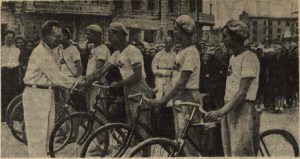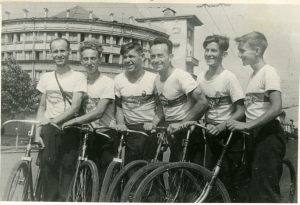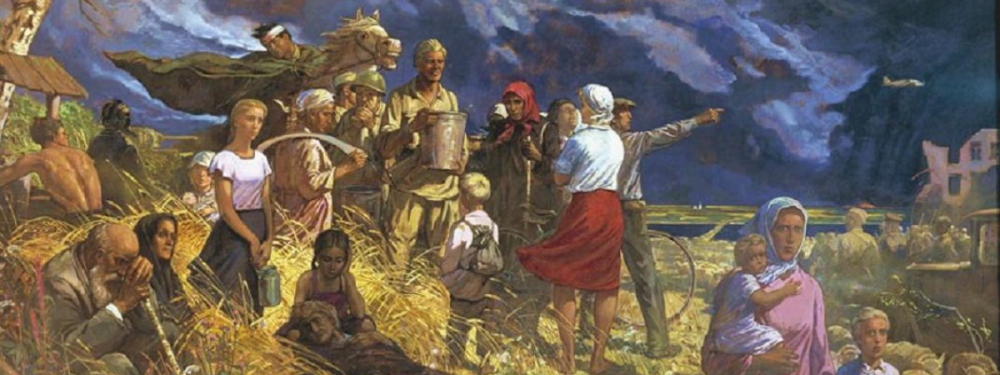This is a re-post of a blog post that I wrote for the AHRC Research Beyond Borders Blog, about my AHRC – International Placement Scheme:
For some research, travel is essential. While the wealth of historical information that’s available online grows by the day, some sources must be delved into first hand.
In today’s blog, Robert Dale – a historian and lecturer in Russian History at Newcastle University – discusses how the AHRC International Placement Scheme helped him bring to life the extraordinary story of six men, including a bricklayer and engineer, who cycled to 2,000 km in the hope of uniting two of Soviet Russia’s largest cities.
One of the greatest challenges faced by researchers, especially social and cultural historians, is to make connections between published record and the archival traces created by different institutions, whose archives are both geographically dispersed and fragmented by decisions about what to preserve.
With persistence, diligence, and a smattering of good luck it is sometimes possible to piece together remarkable stories from materials located in different archives and libraries. For historians of Russia and the Soviet Union this process can involve extensive travel, visiting central archives and libraries in Moscow and St. Petersburg, regional and local archives, and slavonic libraries across the globe. Although ‘archival rats’ like myself enjoy nothing more than immersing themselves in Russian archives and libraries, picking up the threads of different documents gathered and different institutions, and preserved by archives with limited opening hours and access restrictions is far from easy.
My Arts and Humanities Research Council (AHRC) International Placement Scheme Fellowship held in the summer of 2018 enabled me to spend three precious months exploring the riches of the Library of Congress. The collections of the world’s largest library have something for almost every researcher, but the prospect of being able to draw together many different forms of evidence within one Library was truly remarkable.
It wasn’t until I arrived at the library, met the reference specialists in my field, and got set-up in my cubicle in the Kluge Centre that I fully appreciated the opportunity the Fellowship presented.
The project that had taken me to the library was entitled: Rebuilding Socialism: The Reconstruction of the Soviet Union and its Official Ideology Through the Lens of Post-War published sources. As the title indicates, I had anticipated working with newspapers and ideological journals, but it was possible to draw together and make connections between a much wider body of evidence, including microfilmed archival materials, digitized archives, personal papers, newspaper databases, as well as huge collection of Russian language books in the main collection.
Working with these rich collections, and with the help of subject-specialist librarians, it was possible to make some remarkable connections between materials, reconstructing stories which illustrated the wider aims of my research. The project seeks to explore the processes by which Soviet cities and the nation’s physical infrastructure was rebuilt, whilst the political, social, ideological and cultural foundations of Stalinism were simultaneously re-laid. In rebuilding the fabric of urban, and indeed rural society, Soviet citizens were drawn into ideological acts.
In laying new foundations and brickwork, they were also re-establishing communities, relaunching the Soviet project, and creating the future edifice of Socialism. The history of the Soviet Union’s post-war reconstruction was much more than economic history of investment in capital reconstruction, building materials, structures rebuilt, and labour patterns.
Material reconstruction also served the purposes of rebuilding a sense of national community at a time of fragmentation and when many sections of society had been cut-off from the Soviet mainland or had retreated inwards in the interests of survival. A key element in the story of post-war reconstruction, then, was establishing links between cities and communities with divergent wartime experiences and identities.
One episode pieced together in materials accessed at the Library of Congress illustrate these issues particularly eloquently. It was testimony to the richness of the Library’s collections that this remarkable story emerged from the research. On 23 June 1944, whilst the Red Army pushed deeper into Eastern Europe, the executive committee of Stalingrad regional communist party passed a resolution permitting the local Komsomol organisation and the regional committee for Physical Culture and Sport to stage an endurance cycle race between Stalingrad and Leningrad.[1]
The event’s sporting value, aside from as a statement about Soviet masculinity, was secondary to its propaganda value. Although, Stalingrad and Leningrad had very different wartime experiences and faced different post-war problems, this event was designed as an ideological act to unite these two key wartime cities in a statement about the equality of Soviet sacrifice.
On 9 July 1944 a group of six young men set off on a 1950 kilometre journey, taking them through the cities of Tambov, Riazan’, Moscow, Novogorod, before a final leg onwards to Leningrad. The six intrepid individuals selected for this task by the Stalingrad Komsomol were Anton Efimovich Timokhov (a party member, party instructor, and the group’s leader), Ivan Vasil’evich Smol’ianikov (a candidate party member, and recipient of the title “outstanding” Stalingrad city bricklayer), Viktor Borisovich Rostovshchikov (a Komsomol member, defender of Stalingrad, and fitter at Stalingrad’s power station), Boris Aleksandrovich Beliakov (a candidate party member, and tractor factory engineer ), Ivan Vasil’evich Selikov (a mechanic in a tractor factory), and Vladimir Maksimovich Shipilenko (a Komsomol member and electrician at a timber plant).
The profiles of these men suggest that they were selected not because of any special cycling ability or experience in the peloton, but because of their role in Stalingrad’s urban and industrial reconstruction, and their party affiliations. All but Ivan Selikov were either full or candidate members, or Komsomol members.

Stalingrad, 9 July 1944, the cycling team are seen off by M. A. Vodolagin, Secretary of the Stalingrad oblast’ party committee.
A photograph published in the popular magazine Ogonek captured the ceremony that marked the cyclists’ departure from central Stalingrad at 13.00 on 9 July. Proudly holding their bicycles, panniers slung over their crossbars, M. A. Vodolagin, the Secretary of the Stalingrad oblast’ party committee, shakes the hand of one cyclist, furnishing them with a ceremonial letter to the workers of Leningrad from the workers to Stalingrad.
In the background, a crowd of Stalingrad’s citizens, and damaged buildings with unglazed window frames can be seen.[2] The cycling team were also given letters of greeting from the Stalingrad oblast Komsomol and the Stalingrad physical culture administration to deliver to their counterparts in Leningrad.[3] Delivering these letters, and establishing the connection between Stalingrad and Leningrad was a key part of the purpose of the cycle race.
Without access to memoirs or personal papers, we can only speculate what motivated these men to sign-up for this feat of endurance cycling during a time of war. Amidst rationing, widespread hunger, and disrepair on the nation’s road cycling nearly 2000 kilometres was a remarkable undertaking. Perhaps, participation opened up access to better and more plentiful food, an opportunity to escape the ruins of war-ravaged Stalingrad, and the physically draining labour of reconstruction. Nor should we rule out that these six cyclists genuinely believed in the ideological act of uniting the workers of Leningrad and Stalingrad. Certainly, setting out on this endeavour brought a level of public prestige, the opportunity to see more of the country, and visit Leningrad, the Soviet Union’s cultural capital.
According to a report in Pravda published on 19 July 1944, the first 1,200 kilometres of the journey from Stalingrad to Moscow were covered in just six days, an impressive average of 200 kilometres a day. Furthermore, the group had been slowed down by having to walk approximately 150 kilometres of the route because of rain, or more probably because the rain turned unsurfaced road to a quagmire. At 05.00 am on 19 July the group set out from Moscow on the final leg of their journey, after what appears to have been a couple of days rest (and possibly sight-seeing).[4] They finally arrived in Leningrad on 24 July after, according to Izvestiia, just twelve days in the saddle. Here they were greeted by Leningrad dignitaries: a meeting at which the all-important letters of greeting were delivered, followed finally by a physical culture parade.[5]

Leningrad, 24 July 1944.
Left to Right: Anton Efimovich Timokhov (Commander), Boris Alexandrovich Beliakov, Ivan Vasil’evich Smol’ianinov, Viktor Borisovich Rostovshchikov, Vladimir Maksimovich Shipilenko.
Yet having delivered their correspondence, their work was far from done. Whilst in the city they had a number of official engagements, including speaking to meetings about the “heroic defence of Stalingrad and grandiose reconstruction work in the hero city.”
The members of this cycling team were not simply there because of a passion for pedalling, they had a political message to convey about reconstruction. For example, Ivan Smol’ianinov, the prize-winning Stakhanovite bricklayer, visited a Leningrad building site in order to pass on advice about how to over-fulfil brick-laying norms, explaining how he had overfilled norms for a shift by 12 to 14 times.
These activities, designed to rebuild the fabric of Stalinist ideology and community, were of far greater importance than the cycling itself. Indeed, by the end of their visits discussion were underway to try and establish a tradition of an annual cycle race between the two cities, switching the route around each year.
Although this was a remarkable and unusual event, it does reveal some of the mechanism by which post-war reconstruction was harnessed in order to help re-establish a sense of national community and reimpose Stalinist values. Without access to the remarkable resources of the Library of Congress it would have been difficult to piece this together.
[1] Kul’turnoe stroitel’stvo v Volgogradskoi oblasti, 1941-1980 gg. Sbornik dokumentov i materialov. Tom 2 (Volgograd: Nizhne-Volzhskoe knizhnoe izdatel’stvo, 1981), p. 83.
[2] Ogonek, No. 32, 1944, p. 16.
[3] Kul’turnoe stroitel’stvo v Volgogradskoi oblasti, 1941-1980 gg, p. 83.
[4] “Veloprobeg Stalingrad-Moskva-Leningrad,” Pravda, 19 July 1944, p. 4.
[5] “Stalingradskie velosipedisty v Leningrade,” Izvestiia, 25 July 1944, p. 4.
